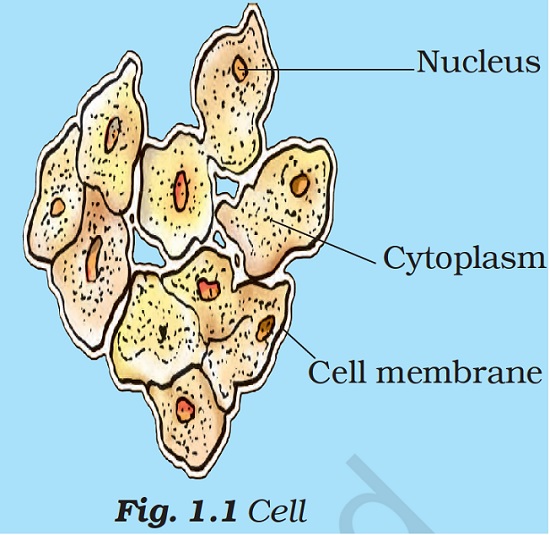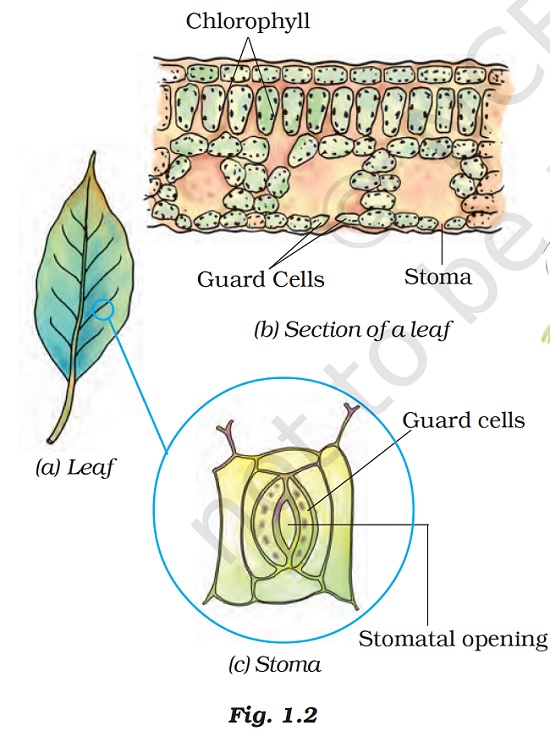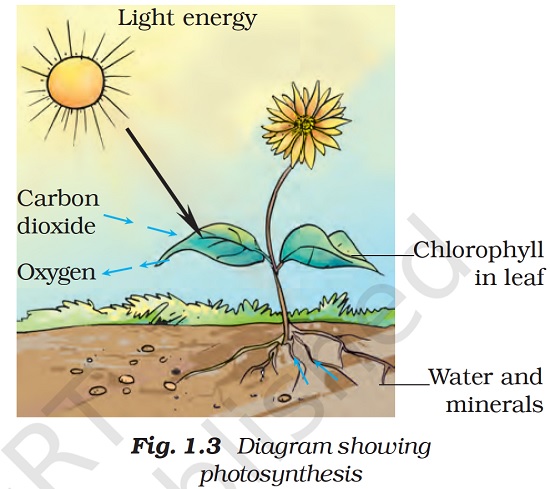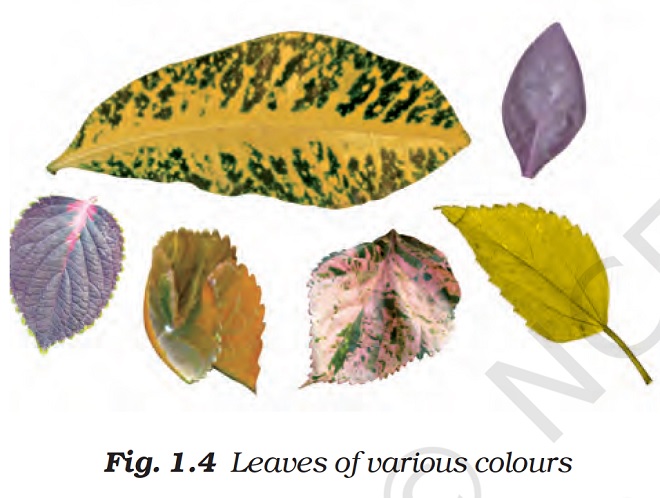1.2 PHOTOSYNTHESIS - FOOD MAKING PROCESS IN PLANTS
NCERT Class 7 Science Textbook for Blind Students made Screen readable by Professor T K Bansal.
Leaves are the food factories of plants. Therefore, all the raw materials required for the preparation of the food must reach the leaf. Water and minerals present in the soil are absorbed by the roots and transported to the leaves. Carbon dioxide from the air is taken in through the tiny pores present on the surface of leaves. These pores are surrounded by ‘guard cells.’ Such pores are called stomata[Figure 1.1 (c)].
Figure 1.1

Boojho wants to know how water and minerals absorbed by roots reach the leaves.
Water and minerals are transported to the leaves by the vessels which run like pipes throughout the root, the stem, the branches and the leaves. They form a continuous path or passage for the nutrients to reach the leaf. They are called vessels. We will learn more about the transport of materials in plants in Chapter 11.
1.2.1 Cells
We have seen that buildings are made of bricks. Similarly, the bodies of living organisms are made of tiny units called cells. Cells are so tiny that they can be seen only under a microscope. Some organisms are made of only one cell. The cell is enclosed by a thin outer boundary, called the cell membrane. Most cells have a distinct, centrally located spherical structure called the nucleus (Figure 1.2). The nucleus is surrounded by a jelly-like substance called cytoplasm.
Figure 1.2

Paheli wants to know what is so special about the leaves that they can synthesize their own food, but other parts of the plant cannot.
The leaves have a green pigment called chlorophyll. It helps leaves to capture the energy of the sunlight. This energy is used to synthesize (prepare) food from carbon dioxide and water. Since the synthesis of food occurs in the presence of sunlight, it is called photosynthesis (Photo means light; synthesis means to combine). So we find that chlorophyll, sunlight, carbon dioxide and water are necessary to carry out the process of photosynthesis. It is a unique process on the earth. The solar energy is captured by the leaves and stored in the plants in the form of food. Thus, the sun is the ultimate source of energy for all living organisms.
Can we imagine life on Earth in the absence of photosynthesis?
In the absence of photosynthesis, there would not be any food. The survival of almost all living organisms directly or indirectly depends upon the food prepared by the plants. Besides, oxygen essential for all organisms' survival is produced during photosynthesis. In the absence of photosynthesis, life would be impossible on the earth.
During photosynthesis, chlorophyll-containing cells of leaves (Figure 1.1), in the presence of sunlight, use carbon dioxide and water to synthesize carbohydrates (Figure 1.3). The process can be represented in an equation: During the process, oxygen is released. The presence of starch in leaves indicates the occurrence of photosynthesis. Starch is also a carbohydrate.
Carbon dioxide + water in the presence of sunlight and chlorophyll → Carbohydrate + oxygen
Figure 1.3 Diagram showing photosynthesis

Besides leaves, photosynthesis also occurs in other green parts of the plant - in green stems and branches. The desert plants have scale- or spine-like leaves to reduce the loss of water by transpiration. These plants have green stems which carry out photosynthesis.
Boojho has observed some plants with deep red, violet or brown leaves. He wants to know whether these leaves also carry out photosynthesis.
Activity 1.1
Take two potted plants of the same kind. Keep one in the dark (or in a black box) Figure 1.2 for 72 hours and the other in sunlight. Perform an iodine test with the leaves of both plants as we did in Class 6. Record your results. Leave the pot, which was kept in the dark, in the sunlight for 3 - 4 days and perform the iodine test again on its leaves. Record your observations in your notebook.
The leaves other than green leaves, also have chlorophyll. The large amount of red, brown and other pigments present in the leaf mask the green colour (Figure 1.4). Photosynthesis takes place in these leaves also.
Figure 1.4 Leaves of various colours

We often see slimy, green patches in ponds or stagnant water bodies. These are generally formed by the growth of organisms called algae. Can you guess why are algae green in colour? They contain chlorophyll which gives them the green colour. Algae can also prepare their own food by photosynthesis.
1.2.2 Synthesis of plant food other than carbohydrates
We have just learnt that plants synthesize carbohydrates through the process of photosynthesis. Carbohydrates are made of carbon, hydrogen and oxygen. These are used to synthesize other components of food such as proteins and fats. But proteins are nitrogenous substances which contain nitrogen. From where do the plants obtain nitrogen? Recall that nitrogen is present in abundance in gaseous form in the air. However, plants cannot absorb nitrogen in this form. Soil has certain bacteria that convert gaseous nitrogen into a usable form and release it into the soil. These are absorbed by the plants along with water. Also, you might have seen farmers adding fertilizers rich in nitrogen to the soil. In this way, the plants fulfil their requirements of nitrogen along with the other constituents. Plants can then synthesize proteins and vitamins.
